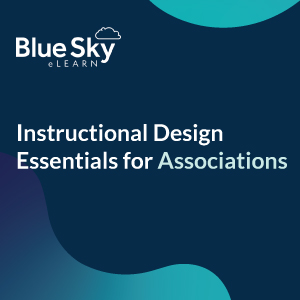
5 Tips to Help Your Association Take Face-to-Face Training Online
As the COVID-19 situation grows, associations across the U.S. and globally are bracing for and dealing with the impacts—including the cancellation or postponement of in-person gatherings such as annual conferences. Unfortunately, these are bread-and-butter events for many. Associations rely on them for the revenue they bring in for the exclusive education, networking, and growth opportunities they offer.
Associations are looking to virtual options to help them adapt, but with time being of the essence, you may find yourself needing to ramp up quickly to keep members engaged and ensure business continuity. Here are five tips to help you do that.
1. Set Your Association’s Priorities
In uncertain times, it’s crucial to bring stakeholders together so everyone can rally around common goals. Consider including decision-makers from program management, membership, advocacy, communications, accounting, and information technology.
Some questions you’ll want to answer include:
- What direction does your association want to take?
- What contributions will you need from different teams and individuals?
- How will you prioritize jobs at hand? Which ones are most critical right now?
- What changes to business processes do you anticipate?
Taking these considerations into account will help you create a solid foundation and ultimately make it easier for you to implement your initiatives.
2. Create Clear Learning Objectives
Learning objectives are statements that define what members can expect to get out of a given course. When you’re making them, the three questions you’ll want to answer are:
- What will learners be doing?
- How will they be assessed?
- What skills, knowledge, or competencies should they have acquired?
For members, learning objectives are valuable in helping them clearly understand the main takeaways and assess how relevant and valuable training will be. They also help staff setting up the courses by giving them guidelines to follow so they can maximize the value of their expertise and time.
3. Blend Created and Curated Content
Adapting in-person content to be delivered online can seem like one of the most daunting parts. Questions often revolve around things like the best tone and how much information is too much versus too little.
Throughout the process, ensure that you:
- Rally around key points and expand on them conversationally. You don’t want to overwhelm learners, but you also don’t want to take away critical context.
- Focus on the tone. As a rule of thumb, the best courses are those that flow like well-thought-out conversations rather than textbook excerpts.
- Keep instructions clear. Adult learners are busy. Explicitly outlining expectations will make it easier for them to complete tasks without having to reach out for clarification.
Building or adding to courses with existing third-party content can also be valuable—especially when time isn’t on your side. When you’re looking at your options, think about what you need (a full course versus supplemental materials), the niche you’re filling (things such as technical training, compliance, or soft skills), and any requirements around content types (specific mediums such as videos or quizzes).
4. Make Experiences Engaging
One of the biggest concerns people have is that in taking experiences online, they will have to sacrifice the interactive and personal elements that make in-person events so successful. Fortunately, there are actions you can take to overcome that:
- Encourage members to collaborate through discussion forums and feedback tools.
- Leverage video-based situational learning to help them hone their skills.
- Reward and motivate them with awards, badges, and leaderboards.
Another great way to bring learning to life is with case studies. Whether they’re introduced right at the beginning of a course or woven throughout, they give members a connection with the material by helping them see how, where, and when the concepts they’re learning can be applied.
5. Communicate the Changes
When you’re coming up with the message you want to send, think about:
- What the initiative is about and the actions you want people to take
- Why it’s relevant for your members
- How it will support their professional development needs and goals
Email is one of the main mediums you’ll use to spread the word, but also consider formats such as lunch-and-learn sessions and quick workshops.
Ultimately, it’s about understanding what you want to get out of your transition to virtual delivery models and using the right tools to streamline and accelerate the adoption journey. This will help your association withstand the current environment and prepare for success down the road.
Andra Popescu is a strategist, change agent and thought leader with deep expertise in transformational and leadership development practices. She’s spent the last decade providing strategic, innovative, research-driven solutions for corporate executives in a variety of industries. She’s keen on empowering people and organizations to align with their mission and achieve business goals. Andra holds an MBA with a focus in Strategy and Brand Management from Ryerson University and an Honors Bachelor of Sciences degree from McMaster University.



